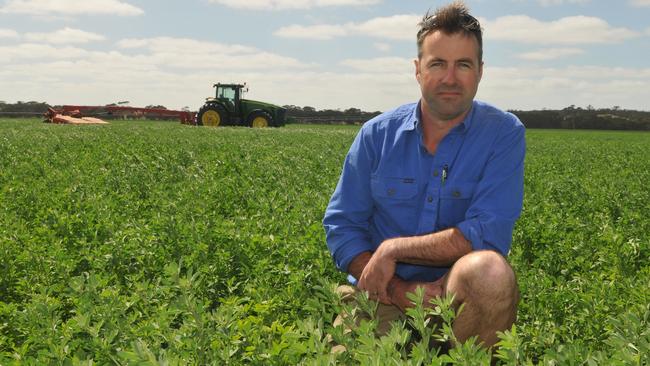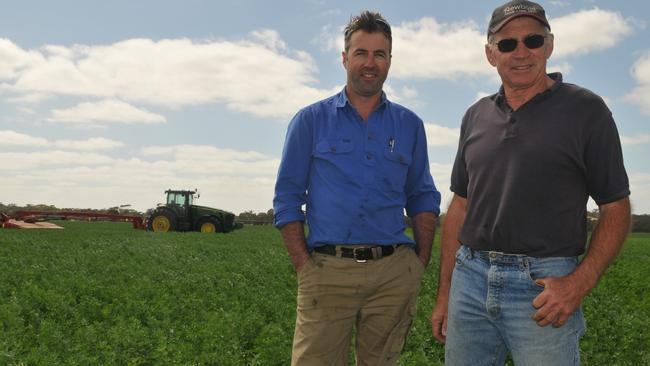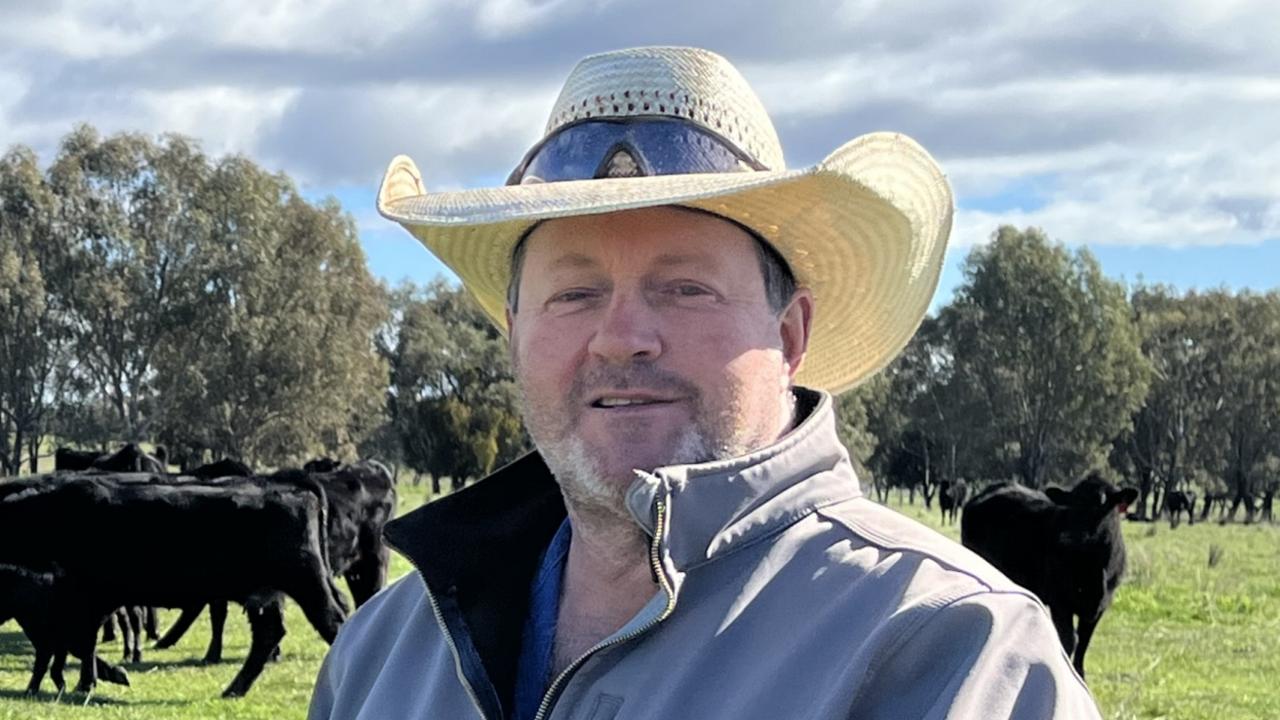Lucerne production: Keith farmer Joe Cook realises green dream
LUCERNE the best of the batch for these South Australian farmers, writes JAMES WAGSTAFF.

IT takes only a few laps in the tractor with South Australian farmer Joe Cook to discover his passion for lucerne seed production.
As he goes about his business cutting his first hay of the season, Joe speaks with great enthusiasm about an industry that has helped transform the farming landscape across parts of South Australia’s South East and is now a major economic driver for communities such as Keith, Naracoorte, Frances and Tintinara.
“Lucerne seed is pretty big business around here nowadays,” says Joe, who began farming his family’s 900ha farm near Keith in 2000.
“Within 100km of Keith there would probably be 80 per cent of Australia’s lucerne seed production and five major seed-cleaning sheds.”
For Joe, it’s an industry that has delivered personal as well as financial rewards.
He is a former chairman of peak industry body Lucerne Australia and now sits on the pasture seeds advisory council of AgriFutures Australia, formerly the Rural Industries Research and Development Corporation.
“It’s been a pretty steep learning curve but pretty rewarding at the same time,” he says. “Lucerne seed is all fairly strategic. You’ve got to be in the right area, you’ve got to have the right water and you’ve got to have the right mentality. Those who do well out of it do very well.”
FAMILY AFFAIR
THE Cook family — which is Joe, his wife Brooke and parents Don and Heather — have owned their property at Keith for more than 20 years.
Irrigated and dryland lucerne is the main game, including 300ha of seed production (which in turn accounts for about 50 per cent of the business). They also grow about 400ha of wheat, barley, lentils, canola and oaten hay and run 1450 Merino ewes joined to Poll Dorset rams to produce crossbred lambs.
The farm sits in a 450mm rainfall zone and Joe said while rainfall was tracking in line with average this year the country had “reacted as if it has been a slightly wet year” after a wetter-than-average year last year.
“In heavier areas in cropping paddocks we’re seeing a little bit of waterlogging in areas you normally wouldn’t see it for 450mm,” Joe said.
The Cooks’ soil is generally sandy over a limestone and clay base.
With lucerne seed production, the Cooks work on getting two cuts of hay from the crop before it is locked up for seed. Joe grows for seed companies Heritage Seeds, PGG Wrightson, Seed Genetics International and Pasture Genetics (“they will give you the seed to plant, you plant it, you grow it and they take it back and they pay you accordingly”) as well as public varieties (“you can sell the seed wherever you see fit”).
The Cooks generally get seven years from a contract seed variety with the crop sown at a rate of 3-5kg of seed per hectare. The first cut of hay takes place in mid-October and yields about 2-2.5 tonnes/ha.
The crop is then watered for a second cut six weeks later. This usually yields about 3-3.5 tonnes/ha. Hay is left on the ground for “as short a time as possible” — ideally it is baled within a week.
“Hay is a race to see how quickly you can get it cured, so the quicker I can get it cured and into a bale the less colour it loses,” Joe said.
“It bleaches the longer it sits out. If I can get it to horse quality and it looks nice and green and leafy, that’s ideal. And if it doesn’t make horse grade it is dairy grade or livestock grade and you go in testing for protein levels etc.”
The Cooks produce large square bales, recently switching to an 8x3x4 baler.
Top-grade hay returns “from the low $200s” to more than $300 a tonne on-farm depending on the quality and season while good dairy grade hay fetches $230-$260 a tonne.
The market base varies according to demand but ranges from “local — within 20km — to interstate”. Joe markets all his own hay, mostly through word of mouth.

SEED FOR THOUGHT
THE Cooks finish cutting hay in early December then enter the seed production phase.
The crops are watered and produce purple, sweet-smelling flowers and the property is “humming with bees” over summer for pollination. There are about 500 hives strategically placed on the farm from the middle of January until the end of February.
Joe said there was a downside with the “bright green, lush paddocks with purple flowers and a scent” attracting “every bug known to man”, including heliosis from as far away as Queensland and NSW. Insecticides are applied at night to avoid any contact with bees.
The Cooks’ fertiliser program comprises 300kg/ha of superpotash in winter for hay production and 200kg/ha in spring or summer for the seed crop. Foliar sprays are continuously carried out throughout the growing season.
On the irrigation front, Joe said a seed crop grown under the farm’s centre pivots required about 4.5 megalitres of water a hectare. Crops watered by flood irrigation used 7-7.5 megalitres a hectare. Crops’ water needs are monitored by moisture probes scattered across the farm.
The water is pumped by bores and has salt content of 2000-3000 parts per million. Joe said lucerne had a tolerance for salt that prohibited lighter crops such as strawberries and flowers from being grown locally.
Seed crops are harvested in March and April. In terms of yields, the “holy grail” is one tonne of seed to a hectare.
The seed is cleaned at Kongal Seeds, bagged and sent away for government testing. About 80-90 per cent is exported, with the US the major market, followed by the Middle East (mostly Saudi Arabia), South America (mostly Argentina) and South Africa. One kilogram of seed is worth about $4-$6/kg.
CEREAL THRILLER
FOR certification purposes, after seven years of a lucerne seed crop, the Cooks are required to “clean” the paddock. They usually do this with one year of irrigated canola followed by wheat and barley.
Looking ahead, Joe said he would like to expand the broadacre cropping side of the business. After a “pretty good season” wheat crops are on track to produce five tonnes/ha while canola could return two to three tonnes/ha (last year it yielded 3.3 tonnes/ha).
Joe said with power required to pump underground water, his current electricity costs were “crazy”.
“The river guys look at our cost of water and cost of land, but they don’t realise we’ve got to pump it,” Joe said.
He said while river irrigators had gravity-fed irrigation systems where, “essentially they get rain water delivered to their doors, they have to “drop $85,000 installing a new pump and motor and bore, and tens of thousands pumping the stuff”.
“We are scratching our heads working out how we can make it a bit more efficient,” Joe said.
“Eight or 10 years ago we went from area-based licences to volumetric licences so a lot of the efficiency gains have already been made, so as far as how many megalitres we’re pumping that’s been sorted out.
“We probably now need to work out how we get the cost per megalitre of water pumped down.”


